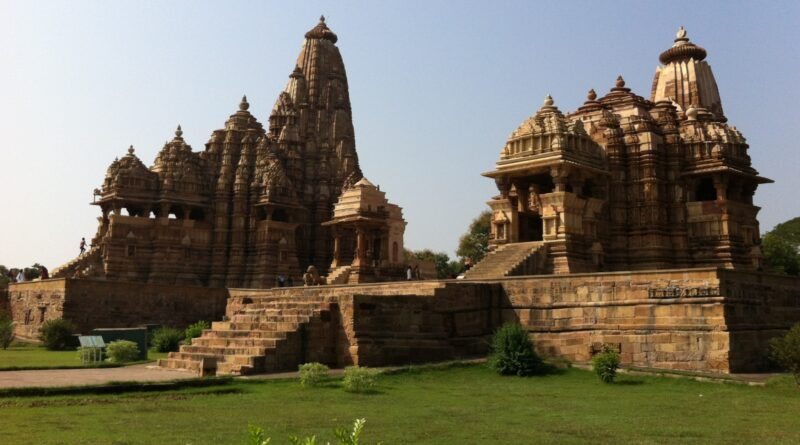Khajuraho Temples and Monuments
Contents
Khajuraho Temples and Monuments: History, Architecture, Sculpture, and Recent Judicial Verdict
Key Takeaway: The Khajuraho Group of Monuments represents the apex of Nagara-style temple architecture from the Chandela dynasty (c. 950–1050 CE), renowned for its harmonious integration of detailed sculptures depicting sacred, secular, and erotic themes. In September 2025, the Supreme Court dismissed a public interest litigation seeking the reconstruction and consecration of a mutilated Lord Vishnu idol at the Javari Temple, ruling the matter falls under the Archaeological Survey of India’s purview and is not a judicial function.
Historical Background
Khajuraho, once known as Kharjuravahaka, flourished under the Chandela dynasty between the 9th and 12th centuries CE. Early Arab travelers such as Al-Biruni (1022 CE) and Ibn Battuta (1335 CE) recorded the existence of some 85 temples scattered across 20 km²; today only 20 temples survive within a 6 km² area owing to time and neglect.
The archaeological evidence indicates simultaneous construction of Hindu (Shaiva, Vaishnava) and Jain temples, reflecting the Chandela rulers’ cultural pluralism and patronage of diverse religious traditions. The major surviving monuments cluster into Western, Eastern, and Southern groups.
Architectural Features
Khajuraho temples epitomize the Nagara-style, characterized by:
Elevated Platform (Jagati): Each temple stands on a highly ornate terraced plinth.
Spatial Hierarchy: Axially aligned spaces including the entrance porch (ardhamandapa), main hall (mandapa), vestibule (antarala), and sanctum (garbhagriha).
Shikhara (Spire): A towering superstructure rising above the sanctum, composed of a central spire flanked by miniature spires, symbolizing Mount Kailasa.
Vastu-Purusha-Mandala Plan: A geometric grid (typically 8×8 padas) organizing the temple’s form around a central Brahma padas housing the deity.
All temples (except one) face east, aligning worshippers with the sunrise and fulfilling Hindu sacred orientation principles.
Sculptural Program and Iconography
The temples’ external and internal walls are profusely carved with over a thousand figures per major monument, integrating:
Divine and Mythological Themes: Depictions of gods, goddesses, celestial beings, and narrative panels from Hindu epics and Puranic lore.
Secular and Daily Life: Scenes of courtly processions, agricultural activities, musicians, teachers, and common folk, reflecting medieval society.
Apsaras and Sura-Sundaris: Graceful nymphs in elaborate jewelry and textiles, celebrating feminine beauty and artistic mastery.
Erotic Sculptures (Maithunas): Representing kama as one of life’s four goals, these explicit panels illustrate various intimate acts and tantric associations, comprising about 10 percent of the iconographic program but often dominating popular perception.
For instance, the Kandariya Mahadeva Temple (c. 1000 CE) features 900+ images, including ascetics, river goddesses (Ganga, Yamuna), and celestial musicians, carved in fine-grained sandstone.
Recent Supreme Court Verdict on Vishnu Idol Reconstruction
On 15 September 2025, the Supreme Court (Chief Justice B R Gavai and Justice K Vinod Chandran) dismissed a petition by Rakesh Dalal seeking judicial directions to reconstruct and consecrate a headless seven-foot Lord Vishnu idol at the Javari Temple within the Khajuraho complex. The Court held:
Jurisdictional Limitations: Restoration of archaeological artifacts falls under the Archaeological Survey of India (ASI), not the judiciary.
Public Interest Litigation Criteria: The bench characterized the plea as motivated by publicity rather than genuine legal grievance, suggesting devotional remedies rather than court orders.
Conservation Norms: Any intervention must comply with ASI’s conservation rules, which generally prohibit reconstruction of mutilated idols to preserve authenticity.
Why Reconstruction Was Denied
ASI’s Exclusive Mandate: The ASI maintains statutory authority over modifications, restorations, and conservation of national heritage sites; courts cannot override these technical guidelines.
Conservation Ethics: International and national conservation principles favor preservation over re-creation to maintain historical integrity.
Judicial Restraint in Religious Affairs: The Court reaffirmed separation between legal adjudication and devotional acts, encouraging petitioners to worship devotional deities rather than seek legal compulsion.
This verdict underscores the legal principle that cultural heritage management remains with specialized agencies, ensuring any alteration to ancient monuments adheres to established archaeological standards.
The Khajuraho temples stand not only as marvels of medieval Indian architecture and sculpture but also as legally protected heritage sites, where restoration practices must balance devotional sentiments with conservation ethics under ASI oversight.
also read: Early Medieval India
Discover more from Simplified UPSC
Subscribe to get the latest posts sent to your email.

